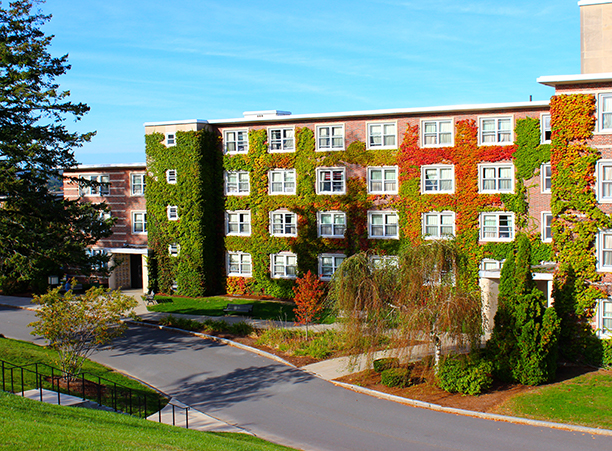
Philip L. Boroughs, S.J., president of the College, announced in his fall address that Brooks-Mulledy Hall will now be known as Brooks Hall.
“In the face of ongoing racial violence and the momentum of the Black Lives Matter movement, statues have toppled and names have been dropped by various colleges and universities, and we have turned again to the issue of the Mulledy name,” Fr. Boroughs said. “I have decided, and our board of trustees, the Jesuit community on campus and our provincial have supported, that we remove the Mulledy name from the residence hall and change the name of Brooks-Mulledy Hall to simply Brooks Hall.”
In his address, Fr. Boroughs explained the history behind the College’s first president, Rev. Thomas F. Mulledy, S.J.: “In 1838, Fr. Mulledy, while serving as provincial of the Maryland province, authorized the sale of 272 enslaved persons owned by the Jesuits to pay off debts at Georgetown University. In the controversy that followed within the Jesuit community, he resigned his position and spent the next five years in a form of exile in Europe.” Mulledy later returned to the U.S. to found the College of the Holy Cross.
In 1966, the College named its newest residence hall after Fr. Mulledy, a decision it re-examined in 2015-2016 when Fr. Boroughs instituted the Mulledy/Healy Legacy Committee to examine the appropriateness of the names on two residence halls in light of connections to slavery. In 1853, Patrick F. Healy, S.J., a Jesuit scholastic at Holy Cross, received $2,300 from the sale of his father's estate in Georgia, which included 49 enslaved persons. Because Healy — the son of a white Irish immigrant farmer and his common-law wife, a mixed-race slave named Eliza Clark — could not keep the money due to his vow of poverty, he received permission from his superiors to donate it to the College, which was rebuilding from a devastating fire the previous year.
After months of meetings and sessions with campus constituencies, the Mulledy/Healy Committee decided not to remove the Healy name, but couldn’t find consensus regarding the Mulledy name. Fr. Boroughs proposed renaming the building as Brooks-Mulledy Hall, to indicate the transformative work of Rev. John Brooks, S.J. ’49, the 29th president of the College, in recruiting several Black men to the College in the early 1970s in order to diversify campus.
“The story of Fr. Mulledy, the source of the Healy gift to the College and the complexity of [his] family’s racial history should be memorialized, studied and taught on our campus, as should the fact that where our campus stands had at one time had been part of the lands of the Native American Nipmuc tribe,” Fr. Boroughs said. “Currently, we are in the process of having plaques fabricated for Brooks Hall and Fenwick Hall that detail this history, as well as a campus plaque referencing the Nipmuc tribal community who once lived here.
“This is only one small step of many more we need to take to become more intentionally anti-racist,” he continued. “As an institution and community, we must continue to research the history of the College and understand that history in connection with the legacy of slavery and persistent social inequities.”
Over the summer, the College announced an evolving anti-racism action plan and the Board of Trustees created a permanent Diversity, Equity and Inclusion Committee of the Board to oversee that work.
In addition to the steps laid over in the summer, Fr. Boroughs announced in late September that the College would observe the federal holiday of Columbus Day as Indigenous Peoples’ Day, and also recognize Juneteenth as an official holiday. These actions, the president said, “serve as a reminder of the enduring struggle for equality and respect by people of color as well as an opportunity to consider the work that we must continue to do together to make our community and our country a place where all people are respected and treated fairly.”
Mulledy Name To Be Removed From Brooks-Mulledy Hall
Long a discussion in the Holy Cross community, the renaming comes as the College pledges to be more intentionally anti-racist
Read Time
3 Minutes